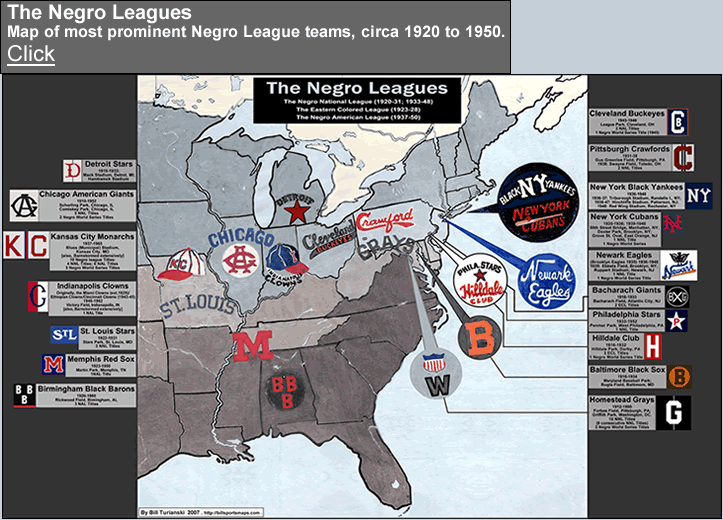By Bill Turianski on the 25th of February 2023; twitter.com/billsportsmaps.
Billsportsmaps.com had its 15th year anniversary, on the 17th of August 2022. So I am posting a series of maps from the early days of this blog. This hand-drawn map was originally posted in November 2007. I have re-posted now, for Black History Month [February].
Denied entrance into Major League Baseball by the color barrier, black ballplayers organized leagues of their own. These were the Negro Leagues, which existed between 1920 and 1957. The primary leagues were the Negro National League (1920-31; and 1933-48); the Negro Southern League, a minor-league (1920-40); the Eastern Colored League (1923-28); and the Negro American League (1937-57). [For purposes of this map, records will only go to 1950, after which the Negro American League, the last negro league, essentially played exhibition games.]
There were many standouts in the Negro Leagues, and 37 Negro League players (as of 2022) have been elected to the Baseball Hall Of Fame. The first five elected were Satchel Paige (the legendary right-handed pitcher); Josh Gibson (catcher, and home run king); James ”Cool Papa” Bell (center fielder, and base-stealer extroardinaire); Buck Leonard (first baseman, slugger); William “Judy” Johnson (third baseman, with a .349 lifetime batting average); and Oscar Charleston (outfielder, and slugger, with a blend of power and speed; and a .376 lifetime batting average). More information about the Negro Leagues can be found at www.blackbaseball.com, and at the Negro Leagues Baseball Museum at nlbm.com, among other good sites.
Negro League baseball was characterized by fleet-footed action, and hi-jinks, ranging from tomfoolery to deadly serious one-upsmanship. There was more base-stealing than in Major League Baseball, and there was a sense of “playing to the crowd.” The teams knew the fans (particularly the significant portion of white customers) were there to see a show, and the players didn’t disappoint. An example of this was the barnstorming (traveling) club called the Indianapolis Clowns, an outfit similar to the Harlem Globetrotters. But that did not mean that Negro League baseball was an inferior product. During this era, negro baseball squads often defeated white MLB squads in exhibition games. Seasons were generally around 60 to 70 games long. There were no real standardized schedules, and teams operated on a shoe-string budget.
The Golden Age of the Negro Leagues can be seen as the period from 1933 to 1947. The Washington-Homestead Grays regularly outdrew the Major League Baseball team the Washington Senators in Griffith Park in Washington DC, as they racked up 9 straight Negro National League titles. The Chicago American Giants played in old Comiskey Park, home of the MLB team the Chicago White Sox. The Pittsburgh Crawfords played in the first entirely black-owned ball park, Greenlee Field, and traveled the country in style, in their custom-made bus. The Newark Eagles won the 1946 NNL title, under Effa Manley (the first woman owner-operator to win a championship; she became the first woman inducted into the Baseball Hall of Fame, in 2006). And the Kansas City Monarchs toured the continent with their state-of-the-art portable lighting system. The Kansas City Monarchs would set up shop most anywhere, playing to thousands on a nightly basis. The Monarchs began using lighting for night games in 1930, five years before MLB teams first did. The KC Monarchs ranged throughout the midwest, the upper midwest and Canada. The Monarchs ended up sending more players to Major League Baseball than any other Negro League team. Their star pitcher, Satchel Paige, made more money than most major leaguers. It was an amazing phenomenon, that only ended when blacks were finally able to play in the Major Leagues. In 1947, Jackie Robinson, of the Brooklyn Dodgers, broke the color barrier, and the Negro Leagues days were numbered. Owners saw their star talent go to the white ball clubs, with no financial compensation. By the mid 1950s, the few surviving Negro League clubs were basically playing exhibition games, and the whole era faded away under the public radar. But the legacy of the Negro Leagues cannot be overstated.
I drew the main map in 2001, using Swiss-made Caran d’Ache watercolor pencils and Rapidograph pens. In 2007, after scanning it, I added the flanking segments. I have included the 17 most prominent Negro Leagues ball clubs.
…
___

